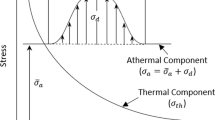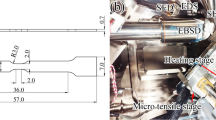Abstract
The temperature influence on the mechanical behaviour during plastic deformation of an AA5754-O aluminium alloy has been investigated by several experimental tests. First, monotonous tensile tests were carried out from room temperature up to 200°C with a classical tensile machine and with a less conventional testing apparatus involving the heating of the sample by Joule effect. With this second testing apparatus, the strain fields and tensile curves were obtained in function of temperature by means of a non-contacting optical 3D deformation measuring system. Moreover, shear tests were performed in the same temperature range. It is shown that the anisotropy coefficients are rather constant within this temperature range, with a relative variation less than 8%. For both tensile and shear tests, the stress levels are similar at the beginning of straining at room temperature and 150°C, except that the Portevin–Le Chatelier (PLC) phenomenon disappears at elevated temperature, and then evolves differently. At 200°C, the stress level is clearly below whatever the deformation. In the framework of drawing process, the formability of this alloy at temperatures higher than 150°C seems to be improved.






















Similar content being viewed by others
References
Keum YT, Ghoo BY (2002) Anisotropy at high temperatures. J Ceram Process Res 3(3):178–181
Li D, Ghosh AK (2004) Biaxial warm forming behavior of aluminum sheet alloys. J Mater Process Technol 145(2):281–293
van den Boogaard AH, Huétink J (2006) Simulation of aluminium sheet forming at elevated temperatures. Comput Methods Appl Mech Eng 195:6691–6709
Abedrabbo N, Pourboghrat F, Carsley J (2006) Forming of aluminum alloys at elevated temperatures—Part 1: material characterization. Int J Plast 22(2):314–341
Kurukuri S, van den Boogaard AH, Miroux A, Holmedal B (2009) Warm forming simulation of Al-Mg sheet. J Mater Process Technol 209(15–16):5636–5645
Chung K, Shah K (1992) Finite element simulation of sheet metal forming for planar anisotropic metals. Int J Plast 8(4):453–476
Geng L, Wagoner RH (2002) Role of plastic anisotropy and its evolution on springback. Int J Mech Sci 44:123–148
Lademo O-G, Hopperstad OS, Langseth M (1999) An evaluation of yield criteria and flow rules for aluminium alloys. Int J Plast 15(2):191–208
Habraken AM (2004) Modelling the plastic anisotropy of metals. Arch Comput Methods Eng 11(1):3–96
Mattiasson K, Sigvant M (2008) An evaluation of some recent yield criteria for industrial simulations of sheet forming processes. Int J Mech Sci 50(4):774–787
Achani D, Hopperstad OS, Lademo O-G (2009) Behaviour of extruded aluminium alloys under proportional and non-proportional strain paths. J Mater Process Technol 209(10):4750–4764
Abedrabbo N, Pourboghrat F, Carsley J (2006) Forming of aluminum alloys at elevated temperatures—Part 2: numerical modeling and experimental verification. Int J Plast 22(2):342–373
Abedrabbo N, Pourboghrat F, Carsley J (2007) Forming of AA5182-O and AA5754-O at elevated temperatures using coupled thermo-mechanical finite element models. Int J Plast 23(5):841–875
Xin-yun W, Hu HE, Ju-chen X (2009) Effect of deformation condition on plastic anisotropy of as-rolled 7,050 aluminum alloy plate. Mater Sci Eng A 515(1–2):1–9
Ravindran R, Manonmani K, Narayanasamy R (2009) An analysis of void coalescence in AL 5052 alloy sheets annealed at different temperatures formed under different stress conditions. Mater Sci Eng A 507(1–2):252–267
Gracio JJ, Barlat F, Rauch EF, Jones PT, Neto VF, Lopes AB (2004) Artificial aging and shear deformation behaviour of 6,022 aluminium alloy. Int J Plast 20(3):427–445
Yoon JW, Barlat F, Gracio JJ, Rauch E (2005) Anisotropic strain hardening behavior in simple shear for cube textured aluminum alloy sheets. Int J Plast 21(12):2426–2447
van den Boogaard AH (2002) Thermally enhanced forming of aluminum sheet—modeling and experiments. PhD thesis, Twente University
Halim H, Wilkinsona DS, Niewczas M (2007) The Portevin–Le Chatelier (PLC) effect and shear band formation in an AA5754 alloy. Acta Mater 55(12):4151–4160
Jiang H, Zhang Q, Chen X, Chen Z, Jiang Z, Wu X, Fan J (2007) Three types of Portevin–Le Chatelier effects: experiment and modelling. Acta Mater 55(7):2219–2228
Picu RC, Vincze G, Ozturk F, Gracio JJ, Barlat F, Maniatty AM (2005) Strain rate sensitivity of the commercial aluminum alloy AA5182. Mater Sci Eng A 390:334–343
Robinson JM, Shaw MP (1994) Serrated flow in aluminum base alloys. Int Mater Rev 39(6):217–227
Wowk D, Pilkey K (2009) Effect of prestrain with a path change on the strain rate sensitivity of AA5754 sheet. Mater Sci Eng A 520(1–2):174–178
Casarotto L, Dierke H, Tutsch R, Neuhäuser H (2009) On nucleation and propagation of PLC bands in an Al3Mg alloy. Mater Sci Eng A 527(1–2):132–140
Laurent H, Grèze R, Manach PY, Thuillier S (2009) Influence of constitutive model in springback prediction using the split-ring test. Int J Mech Sci 51:233–245
Norris SD, Wilson I (1999) Application of 3D numerical modelling for thermal profile optimization on the Gleeble thermomechanical simulator. Model Simul Mater Sci Eng 7:297–309
Grèze R, Manach PY, Laurent H, Thuillier S, Menezes LF (2010) Influence of the temperature on residual stresses and springback effect in an aluminium alloy. Int J Mech Sci 52(9):1094–1100
Kim HS, Koç M (2007) Numerical investigations on springback characteristics of aluminum sheet metal alloys in warm forming conditions. J Mater Process Technol 204(1–3):370–383
Benallal A, Berstad T, Borvik T, Hopperstad OS, Koutiri I, Nogueira de Codes R (2008) An experimental and numerical investigation of the behaviour of AA5083 aluminium alloy in presence of the Portevin–Le Chatelier effect. Int J Plast 24(10):1916–1945
Le Maoût N, Thuillier S, Manach PY (2009) Aluminum alloy damage evolution for different strain paths—application to hemming process. Eng Fract Mech 76(9):1202–1214
Author information
Authors and Affiliations
Corresponding author
Rights and permissions
About this article
Cite this article
Coër, J., Bernard, C., Laurent, H. et al. The Effect of Temperature on Anisotropy Properties of an Aluminium Alloy. Exp Mech 51, 1185–1195 (2011). https://doi.org/10.1007/s11340-010-9415-6
Received:
Accepted:
Published:
Issue Date:
DOI: https://doi.org/10.1007/s11340-010-9415-6




